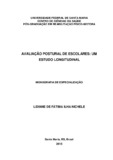| dc.contributor.advisor | Badaró, Ana Fátima Viero | |
| dc.creator | Nichele, Lidiane de Fátima Ilha | |
| dc.date.accessioned | 2017-10-20T11:42:57Z | |
| dc.date.available | 2017-10-20T11:42:57Z | |
| dc.date.issued | 2015-07-10 | |
| dc.date.submitted | 2015 | |
| dc.identifier.uri | http://repositorio.ufsm.br/handle/1/11894 | |
| dc.description | Monografia (especialização) - Universidade Federal de Santa Maria, Centro de Ciências da Saúde, Curso de Especialização em Reabilitação Físico-Motora, RS, 2015. | por |
| dc.description.abstract | Introduction: Childhood and adolescence are important periods of growth in which the position is altered to support the new body proportions. Objective: To characterize the longitudinal profile of body posture in children and adolescents. Method: Children and adolescents of a Philanthropic Institution, aged between 6 and 12 years, were assessed in relation to their weight, height and body posture, during the years 2012 to 2015.The postural evaluation was performed by means of photogrammetry according to the Software Protocol (SAPo v 0.68). The normality of the variables was assessed by the test Shapiro Wilks. The Friedmann test was used to compare variables in the three evaluations. Results: Only 34 of the 100 students made three assessments, characterizing the study sample. Subjects were predominantly eutrophic during the three evaluations. In the evaluation of body posture it was observed significant decreasing differences for the variable frontal angle of the lower limb, Q angle, asymmetry in the frontal plane, horizontal alignment of the pelvis and angle leg/hindfoot and just the angle of the ankle was crescent. Conclusion: The children and adolescents’ posture underwent changes with their growth. It was difficult to justify the findings in the evaluation of body posture due to the lack of reference values of some points that were analyzed and also because of the scarcity of studies that follow longitudinally changes of posture. | eng |
| dc.language | por | por |
| dc.publisher | Universidade Federal de Santa Maria | por |
| dc.rights | Acesso Aberto | por |
| dc.rights | An error occurred on the license name. | * |
| dc.rights.uri | An error occurred getting the license - uri. | * |
| dc.subject | Crescimento | por |
| dc.subject | Criança | por |
| dc.subject | Postura | por |
| dc.subject | Fisioterapia | por |
| dc.subject | Growth | eng |
| dc.subject | Child | eng |
| dc.subject | Adolescent | eng |
| dc.subject | Posture | eng |
| dc.subject | Physical therapy | eng |
| dc.title | Avaliação postural de escolares: um estudo longitudinal | por |
| dc.title.alternative | Posture evaluation in scholars: a longitudinal study | eng |
| dc.type | Trabalho de Conclusão de Curso de Especialização | por |
| dc.degree.local | Santa Maria, RS, Brasil. | por |
| dc.degree.specialization | Reabilitação Físico-Motora | por |
| dc.description.resumo | Introdução: A infância e a adolescência são períodos importantes de desenvolvimento em que a postura sofre alterações para sustentar as novas proporções corporais. Objetivo: Caracterizar o perfil longitudinal da postura corporal de crianças e adolescentes. Método: Foram avaliadas quanto ao peso, a estatura e a postura corporal crianças e adolescentes de ambos os sexos, com idades entre seis e 12 anos, frequentadores de uma Instituição Filantrópica,durante os anos de 2012 a 2015. A avaliação postural foi realizada por meio da biofotogrametria de acordo com o protocolo do Software (SAPo v 0.68). A normalidade das variáveis foi verificada pelo teste Shapiro Wilks. Foi utilizado o teste de Friedmann para a comparação das variáveis nas três avaliações. Resultados: Dos 100 escolares avaliados apenas 34 realizaram 3 avaliações, caracterizando a amostra deste estudo. A maioria dos indivíduos apresentou-se em eutrofia durante as três avaliações. Na avaliação da postura corporal observou-se diferenças significativas decrescentes para as variáveis ângulo frontal do membro inferior, ângulo Q, assimetria no plano frontal, alinhamento horizontal da pelve e ângulo de perna/retropé e crescente apenas o ângulo do tornozelo.Conclusão A postura das crianças e dos adolescentes sofreu modificações com o crescimento. Houve dificuldade para justificar os achados na avaliação da postura corporal devido a falta de valores de referência de alguns pontos analisados e, também, a escassez de estudos que acompanhem longitudinalmente as modificações da postura. | por |
| dc.publisher.country | Brasil | por |
| dc.publisher.initials | UFSM | por |
| dc.subject.cnpq | CNPQ::CIENCIAS DA SAUDE | por |
| dc.publisher.unidade | Centro de Ciências da Saúde | por |


